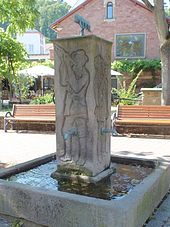Bohemian hunt
The Bohemian hunt was a popular method in the small Palatinate town of Bad Bergzabern and its immediate vicinity until the beginning of the 20th century , using a blowpipe to hunt mountain finches , called Bohemians, which invaded the forests in large flocks in winter .
history
It is not known when the history of the Bohemian hunt began. The first written mention can be found in the church visit files of Leinsweiler in 1593. In the town archive of Bad Bergzabern there is an entry relating to the Bohemian hunt for the year 1777.
The Bohemian hunt was on the one hand a popular activity for men in the winter months, but on the other hand it also served to enrich the menu. The Bohemians were mostly eaten fried. In productive years, hunted birds were even sold to strangers.
With the Reichsvogelschutzgesetz (Reich Bird Protection Act) of 1908, bohemian hunting was affected and forbidden under the prohibition of “catching and killing birds at night with nets or weapons”.
In 1920 some men came together in the local group Bergzabern of the Palatinate Forest Association to form a group of Bohemian hunters. The targets of their blowguns were now artificial, so it was a kind of rifle club that existed until 1939. After the Second World War , the Böhämmer-Jagdclub e.V. was founded in Bergzabern in 1948. V. founded, which exists to this day and has set itself the goal of maintaining the tradition of the Bohemian hunt when shooting at artificial targets and preserving it for posterity.
Since shortly after the hunting ban, the Böhämmerbrunnen in Bad Bergzabern, now in its second version, has been a reminder of the old tradition.
equipment
The blowpipe had a length of about two meters and an inner diameter ( caliber ) of 10 to 14 millimeters. It consisted of two longitudinal halves made of fir or spruce wood, which were lined with hardwood. The projectiles were clay balls that were calibrated during their manufacture by drilling a hole in an iron sheet.
The hunting target was illuminated with a so-called ignition pan, a metal basket on a long pole in which pine wood was burned.
The pinewood, the provisions of the hunting party and the hunted booty were transported in baskets carried on the back, the back coits. This equipment determined the three different functions in a hunting party, shooter, lighting technician and porter.
Course of the hunt
The mountain finch, which is native to the Nordic countries in summer, migrates in large flocks to Central Europe in winter and prefers the food supply because of forests with beech stocks , which are abundant in the Palatinate Forest . The animals have the property of sleeping closely packed in a row at night. If one suddenly falls out of this row without causing a stir, the others move up and close the gap. The light from an ignition pan does not disturb them. Several animals could be shot one after the other with the blowpipe. The condition was not to make any noise and to kill the birds so that they would not be alarmed. An alarmed swarm never returned to this place.
Bohemian hunting parties were often out for several days, slept during the day and hunted at night.
literature
- August Becker : Nocturnal activity in the Wasgenwald . In: The Gazebo . Issue 1, 1878, pp. 8–12 ( full text [ Wikisource ]).
- August Becker: Hedwig . First book - The story of the Bohemians. Verlag Otto Janke, Berlin 1868 ( google.de ).
Web links
Individual evidence
- ↑ Böhämmer . In: Palatinate dictionary
- ^ Text of the Bird Protection Act of 1908
- ↑ Koze . In: Palatinate dictionary (with illustration)
- ^ August Becker : Nocturnal activity in the Wasgenwald . In: The Gazebo . Issue 1, 1878, pp. 11 ( full text [ Wikisource ]).



